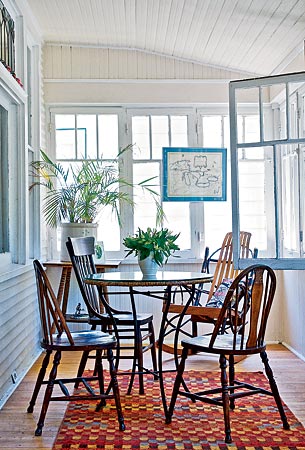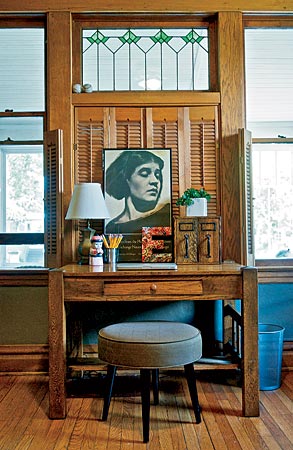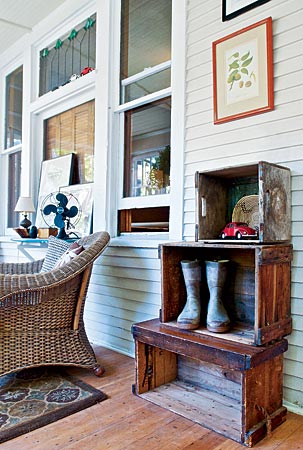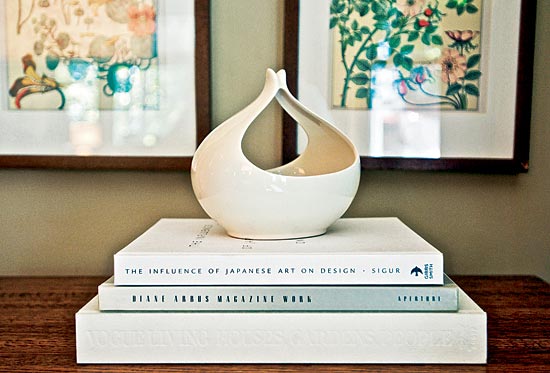
In this Oak Park bungalow, Kelly + Olive rearranged the owners’ existing furniture and accessories. On the enclosed front porch, the redesigners made a defined dining area and hung an old map from a window frame.
More Design Ideas
A: Who doesn’t wish they had a cool friend who would come in, move that Monet a liiiittle to the left, and—voilà!—make a room look fantastic? If you’re on a budget, working with furniture and accessories you already own is an attractive option. You’re in luck: Thanks to the recession, home restaging is taking off—it’s less invasive and less expensive than the traditional interior design job. Sometimes called interior stylists (also stagers, redesigners, rearrangers, and one-day makeover artists), these people specialize in rearranging furniture, suggesting paint colors and finishes, and finding art and accessories to create that voilà! effect.
The cost is usually per room ($250 is a common rate), though some charge by the hour (perhaps $50), and you pay for furniture, accessories, paint, and labor (no markup). If you admire the work of a traditional designer, ask if he or she is willing to do an hourly redesign project; given the economy, many will.
Jeff Shuler created REarrange (2064 N. Damen Ave., 773-904-8604, rearrangeyourhome.com) last August as an alternative to his interior design firm, Jeff Shuler Studio. “Not everyone can afford to buy everything new, and why would you want to? It’s nice to have pieces of history,” Shuler says.
After a free in-home consultation, Shuler and his associates make an appointment to take over the client’s home for a few hours: They’ll rehang art, move furniture from room to room, suggest paint colors, and even bring lamps or throw pillows as suggested purchases. About a week and $400 later, there’s a nicely designed living room where that black-hole-with-sofa used to be.
Expect to be more heavily involved in the process with an organizer or makeover artist than you might be with a traditional designer. Courtney Davis and Lauren Paradise, co-owners of Kelly + Olive (kellyandolive.com), will ask you what kind of music gets you dancing and where your passport has been stamped. From there, they’ll scour the Internet, tear up magazines, and window shop to put together suggestions that you enact.
“A lot of people come to us because they find the traditional interior design process intimidating, out of their reach, like someone’s going to come in and say, ‘Oh, you need this $6,000 couch,’” says Paradise. “That’s not realistic for many lifestyles. We’re more accessible.” Davis says the ideal client “has that instinct to get things done, but needs a director or a friend to help them out so they don’t feel overwhelmed.”
REarrange will give you assignments, as well—one might be to create “a love pile, a hate pile, a do-I-really-need pile.” Says Shuler, “Our job is to interpret what you want and to bring it to life. It shouldn’t reflect our tastes; it should reflect your tastes.”
Who’s not a candidate for restyling? If your home hasn’t been looked at in decades or if it’s really run-down, you might have no choice but to hire a full-tilt interior design firm, Shuler says. But if you just feel stuck or you’ve undergone a life transition like having a baby or moving to the city, bringing in a fresh eye to reinvigorate your space might be a good idea.
Davis and Paradise did a job recently for a couple who had just had a child; there was nowhere to sit, and the living room was carpeted in toys. They reupholstered thrift-store finds, bought some accessories, and replaced the coffee table with a storage ottoman. “The toys could be scooped up and out of sight in minutes,” Davis says.
Part of what these pros do is get you to see your things in a different light. Shuler likes to modernize furniture by changing out brass handles for silver ones or applying new wood finishes. Davis says people tend to think of furniture as “a living-room chair” or “a bedroom table” just because the thing has always been in that room; a simple rearrangement fixes that thinking.
Among the most common design mistakes Davis and Paradise encounter is furniture pushed up against the walls, with mostly empty space in the middle. “There’s always an impulse to have all furniture facing the television,” Davis says. “It’s functional, but do you watch TV every second of the day?” The television’s place is usually dictated by a cable hookup, so she encourages clients to move the outlet, if necessary.
Then there’s the clutter problem. Many of us simply have too much stuff, and it either becomes invisible to us or we think we can’t bear to part with it. Or both. Redesigners will generally start a job by assessing how you actually use things. “If there’s one spot in the kitchen where everything gets piled, we have to rethink that corner,” says Shuler.
The goal is to come up with an organizational system that matches your habits. For example, if you look at your mail only once a week, Shuler will set up a specific spot to stash it between weekly check-ins. One of Kelly + Olive’s favorite decluttering tricks is to take things a client seems to accumulate but has no dedicated place for—from toy cars to vintage pop bottles—and display them as collections. “It makes it look intentional, like a theme,” Davis says.
Ready to take the plunge? A few other local pros to consider include Julea Joseph of Reinventing Space (708-448-7500, julea.com), All in a Day (773-294-2743, allinadayllc.com), Redesign Doctor (847-687-5957, redesigndoctor.com), and InFocus Design Services (708-672-9668, infocusdesignonline.com). Or consult the Interior Stylist Network (interiorstylist.org).
Photography: Tate Gunnerson

Pushing a desk in front of closed shutters created a focal point in the study; replacing a chair with a stool lightened the mood.

Wooden boxes that had been scattered around the front porch were stacked, making a boot/shoe nook.

Why hide this pretty Eva Zeisel gravy boat in a cabinet?
Have a design or renovation question? Just drop us a note at chicagohome@chicagomag.com and we’ll do our best to answer it. Sorry, we cannot take questions by phone, or guarantee individual responses.
Photography: Tate Gunnerson



